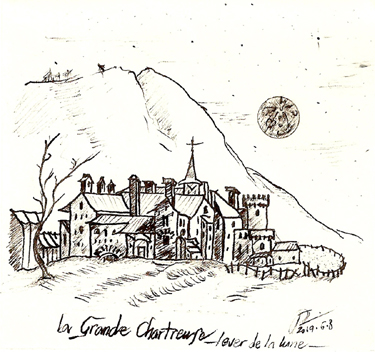A 17th-century monastic advocate of female particiupation in the learned world (Dom Bonaventure also had an interest in astronomy; image © by R.A. Rosenfeld)
As the persona of Heather states in the podcast, in the Republic of Letters “knowledge was pursued in a barrier-free environment for the good of everyone, there was a sense of inclusive shared enterprise, and technologies of communication were vital in ensuring the continued contact of scientific citizens. It’s a very attractive concept to anyone who prefers the spirit of disinterested pure research to the other kind, who believes in the benefits of research teams drawn from different labs, the power of citizen science, and the open acknowledgement of a connection joining the efforts of past, present, and future investigators”. To which her interlocutor adds: “The ideal characteristics of the Republic of Letters—tolerant inclusiveness, diversity, openness, and meritocracy—are worth remembering, and cultivating. Particularly in the present world”. It makes for a good environment for productive intellectual interchange—and it unsettles populists.
An good account of the "original" concept of the Republic of Letters can be found in Tony Grafton's commendable "A Sketch Map of a Lost Continent: The Republic of Letters", in the aptly named Republic of Letters. The concept has remained alive in the learned world with greater or lesser force since the early-modern period. The author of a recent study has seen the patterns of behavior of those invovled in the founding of the International Astronomical Union as reflecting the expectations established by the Republic of Letters: Arnaud Saint-Martin, “The Creation of the International Astronomical Union as a Result of Scientific Diplomacy”, in The Role of Astronomy in Society and Culture, Proceedings of the International Astronomical Union, vol. 5, Symposium No. 260 (2009), ed. D. Valls-Gabaud & A. Boksenberg (IAU: Cambridge, 2011), pp. 202-206, at 205.
Dom Bonaventure, the intriguing figure with whom we start this episode, remains somewhat elusive. The only full length study devoted to him is B. Rountree, Bonaventure d’Argonne: the Seventeenth Century’s Enigmatic Carthusian (Geneva: Librairie Droz S.A.,1980). Dom Bonaventure's essay on the Republic of Letters was published under a pseudonym in Mêlanges d’histoire et de litterature, recueillis par M. De Vigneul-Marville, nouvelle edition, revûë, corrigée, et augmentée, 2 (Paris: Claude Prudhomme, 1713), pp. 67-71. A full translation into English can be found in R.A. Rosenfeld, "Republic of Letters", JRASC 113, 4 (2019 August), 157-160, at p. 159. That same paper explains how the RASC fits into the tradition of the Republic of Letters.
The mechanics of the Republic of Letters can be seen in exchanges from the time of the Society's revival in the last decade of the 19th century. It is an interchange of mutual scholarly obligaitons, and patronage requested, extended, and gratefully received:
“Letters of acknowledgment, and, in several instances, of a very complimentary character, were read from the following gentlemen, to whom had been sent copies of the Society’s first Report : —The Honourable G. W. Ross, LL.D., Minister of Education for the Province of Ontario ; the Secretary of The Royal Society of Canada ; Professor E. C. Pickering, Director of Harvard Observatory ; Professor S. B. Langley, Secretary of the Smithsonian Institute ; Professor W. W. Payne, Editor of The Sidereal Messenger ; Professor Edgar Frisby, of Washington, D.C.; Sanford Fleming, C.E., LL.D., C.M.G., of Ottawa; Professor E. S. Holden, Director of the Lick Observatory ; Professor S. W. Burnham, of the Lick Observatory ; Professor Daniel Kirkwood, LL.D., of Riverside, Cal.; Captain McNair, Director of the United States Naval Observatory ; and Mr. J. A. Brashear, of Allegheny, Penn. Professor Burnham also sent a large number of valuable papers relating to double-stars, for which he received the Society’s thanks. The Minister of Education wished the Society success in the work it had undertaken, and, in reply to an enquiry, expressed his willingness to preside at a public meeting, should one be held”; Transactions of the Astronomical And Physical Society of Toronto, for the Year 1891 (1892), 21 (meeting of 1891 June 16);
and
“Among the letters read were communications from Professor Newcomb, Superintendent of the Nautical Almanac Office at Washington, as to the computation of certain quantities published in the Tables of Star Occultations ; from Professor G. E. Hale, Director of the Kenwood Observatory ; from Professor Payne, editor of Astronomy and Astro-Physics and Popular Astronomy ; from Sir Robert S. Ball, Lowndean Professor of Astronomy and Mathematics in the University of Cambridge, thanking the Society for a report of the bolide seen at Toronto, July 7th, by Mr. R. A. Eaton ; from the Librarian of the Smithsonian Institution…”; Transactions of the Astronomical And Physical Society of Toronto, for the Year 1893 (1894), 86 (meeting of 1893 September 19).
In some cases the letters themselves survive, Examples are:
J.E. Keeler (1857-1900)
https://www.rasc.ca/18930102-keeler agrees modesty
https://www.rasc.ca/18940117-keeler contributes
https://www.rasc.ca/18941010-keeler observing
E.E. Barnard (1857-1923), offprint
https://www.rasc.ca/ee-barnard-autograph
Agnes Mary Clerke (1842-1907)
https://www.rasc.ca/18931013-clerke contributes paper, expresses wishes for the prosperity of the Society
Sir William Henry Mahoney Christie KCB FRS (1845-1922), Astronomer Royal (1881-1922)
Transactions of the Astronomical and Physical Society of Toronto, for the Year 1891 (1892), TAPST 1891 51
Sir William Huggins (1824-1910), FRS
https://www.rasc.ca/18911203-huggins good wishes
Sherburne Wesley Burnham (1838-1921)
https://www.rasc.ca/18901219-burnham observing advice
—R.A. Rosenfeld
A transcript of this podcast available.
| Attachment | Size |
|---|---|
| 9.52 MB | |
| 189.81 KB |

